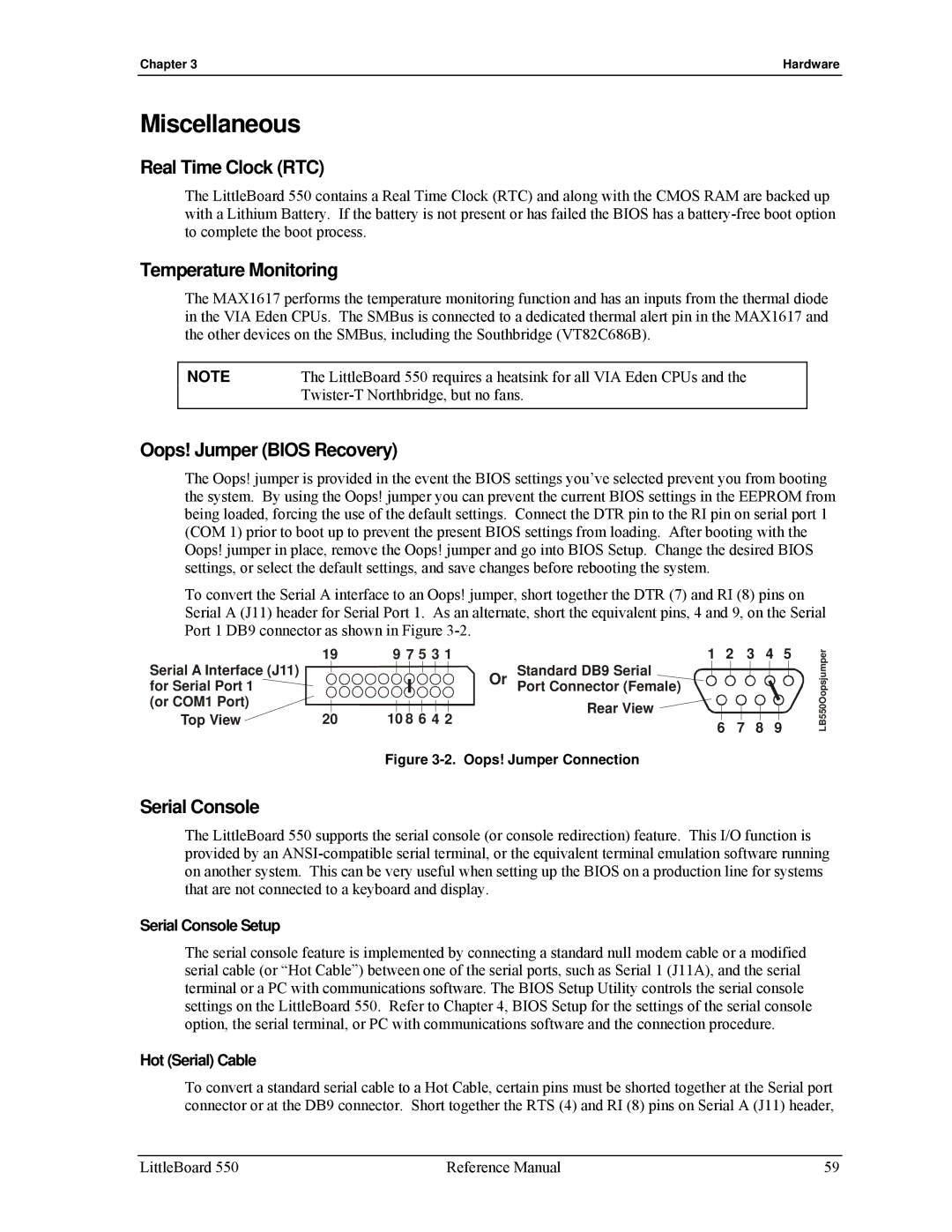
Chapter 3 | Hardware |
Miscellaneous
Real Time Clock (RTC)
The LittleBoard 550 contains a Real Time Clock (RTC) and along with the CMOS RAM are backed up with a Lithium Battery. If the battery is not present or has failed the BIOS has a
Temperature Monitoring
The MAX1617 performs the temperature monitoring function and has an inputs from the thermal diode in the VIA Eden CPUs. The SMBus is connected to a dedicated thermal alert pin in the MAX1617 and the other devices on the SMBus, including the Southbridge (VT82C686B).
NOTE | The LittleBoard 550 requires a heatsink for all VIA Eden CPUs and the |
| |
|
|
Oops! Jumper (BIOS Recovery)
The Oops! jumper is provided in the event the BIOS settings you’ve selected prevent you from booting the system. By using the Oops! jumper you can prevent the current BIOS settings in the EEPROM from being loaded, forcing the use of the default settings. Connect the DTR pin to the RI pin on serial port 1 (COM 1) prior to boot up to prevent the present BIOS settings from loading. After booting with the Oops! jumper in place, remove the Oops! jumper and go into BIOS Setup. Change the desired BIOS settings, or select the default settings, and save changes before rebooting the system.
To convert the Serial A interface to an Oops! jumper, short together the DTR (7) and RI (8) pins on Serial A (J11) header for Serial Port 1. As an alternate, short the equivalent pins, 4 and 9, on the Serial Port 1 DB9 connector as shown in Figure
Serial A Interface (J11) | 19 | 9 7 5 3 1 | 1 | 2 | 3 | 4 | 5 | |
| Or | Standard DB9 Serial |
|
|
|
| ||
for Serial Port 1 |
| Port Connector (Female) |
|
|
|
| ||
(or COM1 Port) | 20 | 10 8 6 4 2 | Rear View |
|
|
|
| |
Top View | 6 | 7 | 8 | 9 | ||||
| ||||||||
|
|
|
|
Figure 3-2. Oops! Jumper Connection
LB550Oopsjumper
Serial Console
The LittleBoard 550 supports the serial console (or console redirection) feature. This I/O function is provided by an
Serial Console Setup
The serial console feature is implemented by connecting a standard null modem cable or a modified serial cable (or “Hot Cable”) between one of the serial ports, such as Serial 1 (J11A), and the serial terminal or a PC with communications software. The BIOS Setup Utility controls the serial console settings on the LittleBoard 550. Refer to Chapter 4, BIOS Setup for the settings of the serial console option, the serial terminal, or PC with communications software and the connection procedure.
Hot (Serial) Cable
To convert a standard serial cable to a Hot Cable, certain pins must be shorted together at the Serial port connector or at the DB9 connector. Short together the RTS (4) and RI (8) pins on Serial A (J11) header,
LittleBoard 550 | Reference Manual | 59 |
